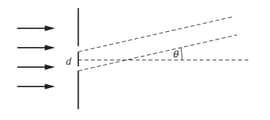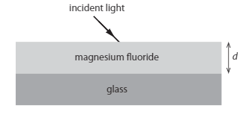A coherent light of wavelength is incident on two parallel slits that are separated by a distance . Angle is the smallest separation for which the two rays showed interference destructively on a screen far from the slit.

Which of the following could be correct?


Important Questions on Wave Phenomena (HL)
A light is incident essentially normally on a thin film of thickness and refractive index , The film is on a transparent glass of refractive index . Which of the following condition of the wavelength in oil leads to the destructive interference of the reflective light

Monochromatic light of wavelength in air is incident on a rectangular piece of glass of refractive index 1.60 that is coated by a thin layer of magnesium fluoride of refractive index 1.38.

Copy and complete this diagram by drawing the paths of the two rays, originating with the incident ray, that will interfere in the eye of an observer looking down on the glass from above.
